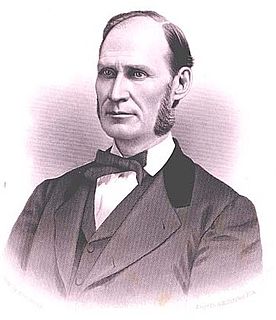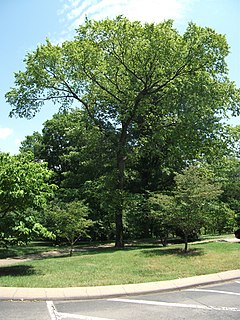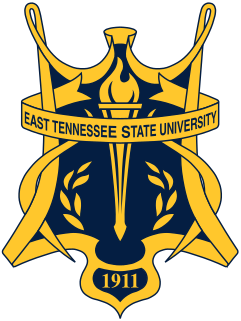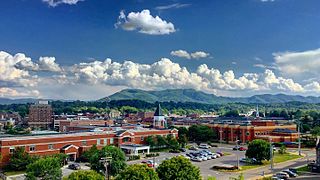
Tennessee is a state located in the southeastern region of the United States. Tennessee is the 36th largest and the 16th most populous of the 50 United States. Tennessee is bordered by Kentucky to the north, Virginia to the northeast, North Carolina to the east, Georgia, Alabama, and Mississippi to the south, Arkansas to the west, and Missouri to the northwest. The Appalachian Mountains dominate the eastern part of the state, and the Mississippi River forms the state's western border. Nashville is the state's capital and largest city, with a 2017 population of 667,560. Tennessee's second largest city is Memphis, which had a population of 652,236 in 2017.

Edward Hazzard East was an American attorney, judge, and politician. He served as Secretary of State for the state of Tennessee from 1862 to 1865, having been appointed by Andrew Johnson, the state's military governor under the Union Army occupation during the Civil War. East briefly served as the state's acting governor during the interim between Johnson's inauguration as U.S. Vice President on March 4, 1865, and the inauguration of the state's "elected" governor, William G. Brownlow, on April 5, 1865.
Sehome, also called Sehome Hill, is a forested hill in Bellingham, Washington. The Sehome Hill Arboretum is an 180-acre (73-hectare) park of second growth forest is located on the hill, adjacent to the campus of Western Washington University. Though called an arboretum, the hilly expanse atop Sehome is not consciously planted as an exhibit of tree species, but naturally wooded and rich in the plant species typical of the region. The arboretum is jointly managed by both the university and the city. Its care is overseen by the Sehome Arboretum Board of Governors, composed of city employees, university employees, university students, and city residents. The park offers students and city dwellers over 5 miles (8 km) of public trails for walking and running and, in some areas, bicycling. Unique features of the park include an 80-foot (24 m) wooden observation tower atop Sehome, with aerial views of Bellingham Bay to the south. There is also a large tunnel, hand cut into rock in 1923, originally used for car traffic in the early 1900s. Its tall, thin shape shows its creation for cars like Model T Fords of the day. Cars are no longer allowed in the tunnel and it is part of a trail along which hikers can walk.

Central Gardens is a historic Memphis neighborhood in Midtown. It has been named one of North America's best "Old House Neighborhoods."

Ulmus crassifoliaNutt., the Texas cedar elm or simply cedar elm, is a deciduous tree native to south central North America, mainly in southern and eastern Texas, southern Oklahoma, Arkansas and Louisiana, with small populations in western Mississippi, southwest Tennessee and north central Florida; it also occurs in northeastern Mexico. It is the most common elm tree in Texas. The tree typically grows well in flat valley bottom areas referred to as 'Cedar Elm Flats'. The common name 'cedar elm' is derived from the trees' association with juniper trees, locally known as cedars.

Chadwick Arboretum is a 62 acres (25 ha) arboretum on the Agriculture campus of The Ohio State University, in Columbus, Ohio, United States. The main arboretum collection is located just across Lane Avenue from the Schottenstein Center with its other collections nearby. The arboretum is open daily without charge.
The Gerald D. Coorts Memorial Arboretum is an arboretum located on the campus of Tennessee Technological University in Cookeville, Tennessee.

The Lady Bird Johnson Wildflower Center at The University of Texas at Austin is the state botanical garden and arboretum of Texas. The center features more than 900 species of native Texas plants in both garden and natural settings and is home to a breadth of educational programs and events. The center is 284 acres and located 10 miles southwest of downtown Austin, Texas just inside the edge of the distinctive Texas hill country. It straddles both Edwards Plateau and Texas Blackland Prairies ecosystems.

The University of Tennessee Arboretum is a research and educational arboretum operated by the University of Tennessee Agricultural Experiment Station. It is located at 901 South Illinois Avenue, Oak Ridge, Tennessee. It is open to the public without charge. Outdoor areas are open daily from 8:00 a.m. until sunset; the office and visitor center are open weekdays during normal office hours.

The Old Forest Arboretum of Overton Park is a forest tract and natural arboretum located in Overton Park, Memphis, Tennessee. It is open to the public daily without charge. The forest was placed on the National Register of Historic Places in 1979 as part of the Overton Park Historic District. Tree identification began in 1997, with some 70 tree species identified by 2002 when it was certified as an arboretum. Today the arboretum contains walking trails with 49 tree markers identifying 32 species. Approximately three-fourths of the Arboretum was designated as the Old Forest State Natural Area in 2011.

Ulmus serotinaSarg., the September elm, is an American species uncommon beyond Tennessee; only very locally distributed through Illinois, Kentucky, Arkansas, Mississippi, Oklahoma, Alabama and Georgia, and disjunct into Nuevo León, Mexico. It grows predominantly on limestone bluffs and along streams to elevations of 400 m.

The following outline is provided as an overview of and topical guide to Tennessee:

The East Tennessee State Buccaneers football program is the intercollegiate American football team for East Tennessee State University (ETSU) located in Johnson City, Tennessee. The team was dormant from the end of the 2003 season until being reinstated for the 2015 season. They played all of their 2015 home games and all but one of their 2016 home games at Kermit Tipton Stadium before the opening of the new William B. Greene Jr. Stadium for the 2017 season. The remaining 2016 home game, against Western Carolina on September 17, was played at nearby Bristol Motor Speedway. Before ETSU dropped football, it competed in NCAA Division I as a Southern Conference (SoCon) football program. The revived program played as an independent in 2015 before returning to the SoCon in 2016.

The Ulmus pumila cultivar 'Aurescens' was introduced by Georg Dieck at the National Arboretum, Zöschen, Germany circa 1885. Dieck grew the tree from seed collected in the Ili valley, Turkestan by the lawyer and amateur naturalist Vladislav E. Niedzwiecki while in exile there. Dieck originally named the tree U. pinnato-ramosaf.aurescens.

William B. Greene Jr. Stadium is a football stadium on the campus of East Tennessee State University (ETSU) in Johnson City, Tennessee. The stadium is named after businessman and longtime ETSU supporter William B. Greene Jr. Located on the southwestern corner of campus at the foot of Buffalo Mountain, the new stadium is expected to have a seated capacity of over 7,000, plus standing room for an additional 3,000, and will cost roughly $26.615 million. The stadium is home to the newly resumed East Tennessee State Buccaneers football team, which played their 2015 and 2016 seasons at Kermit Tipton Stadium on the campus of Science Hill High School.














